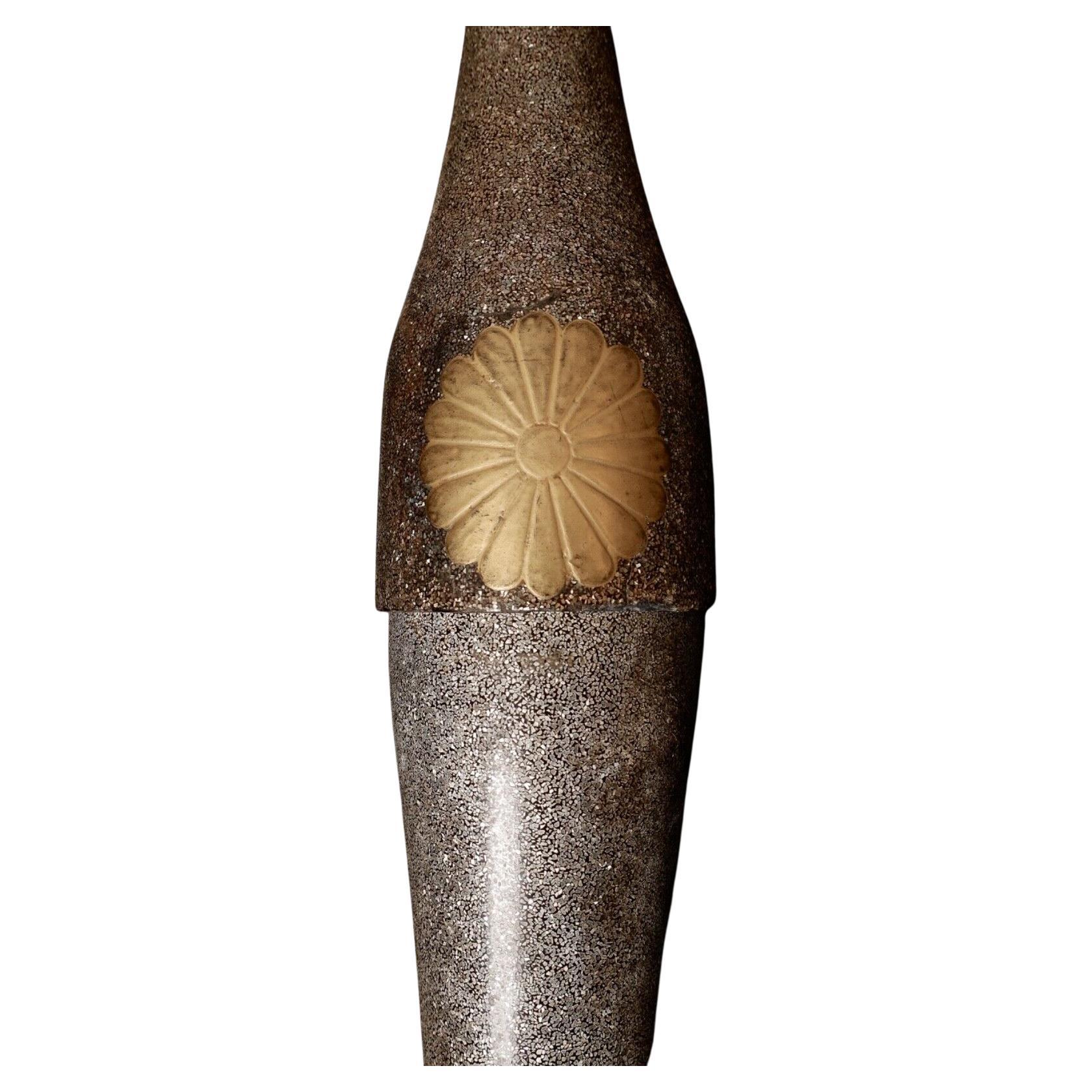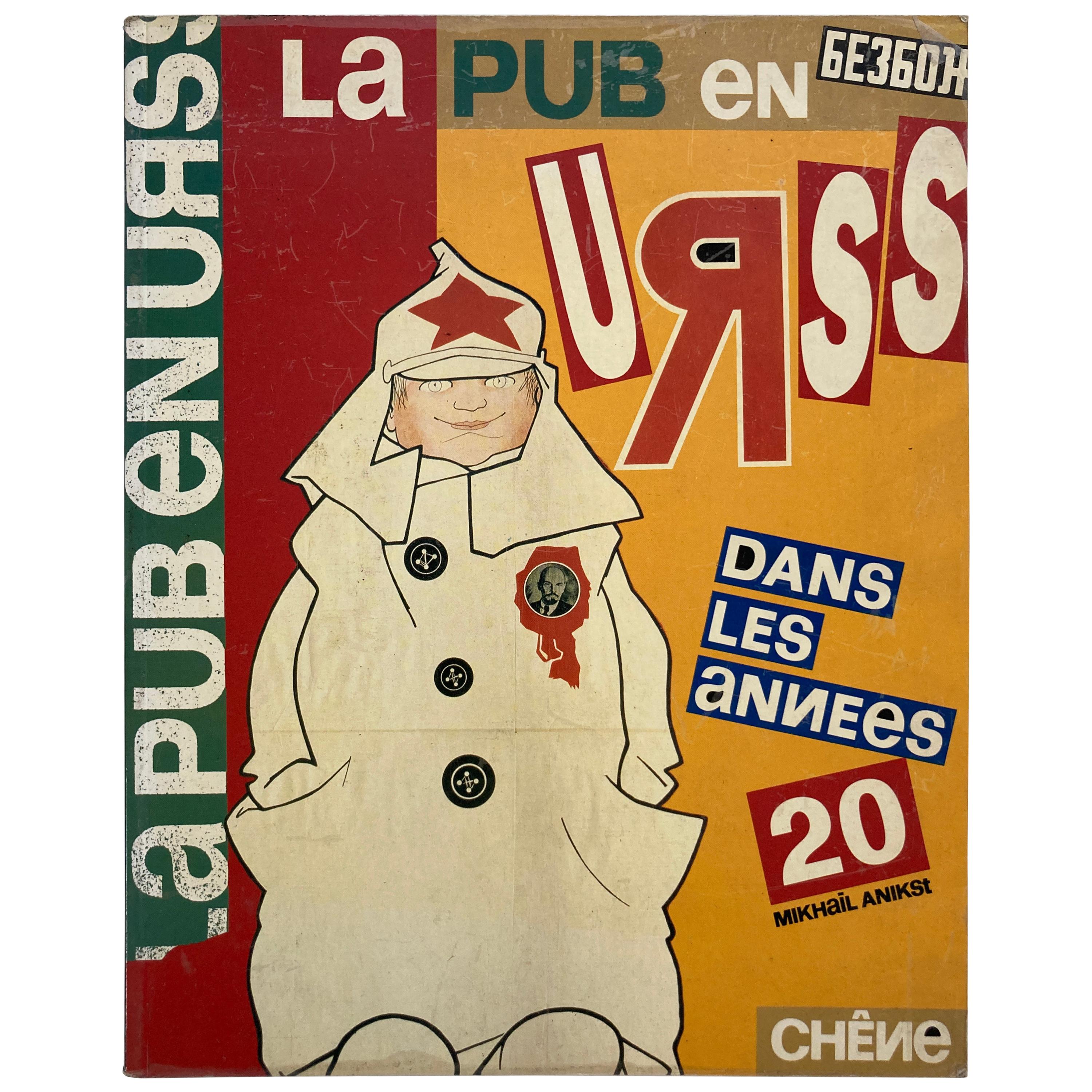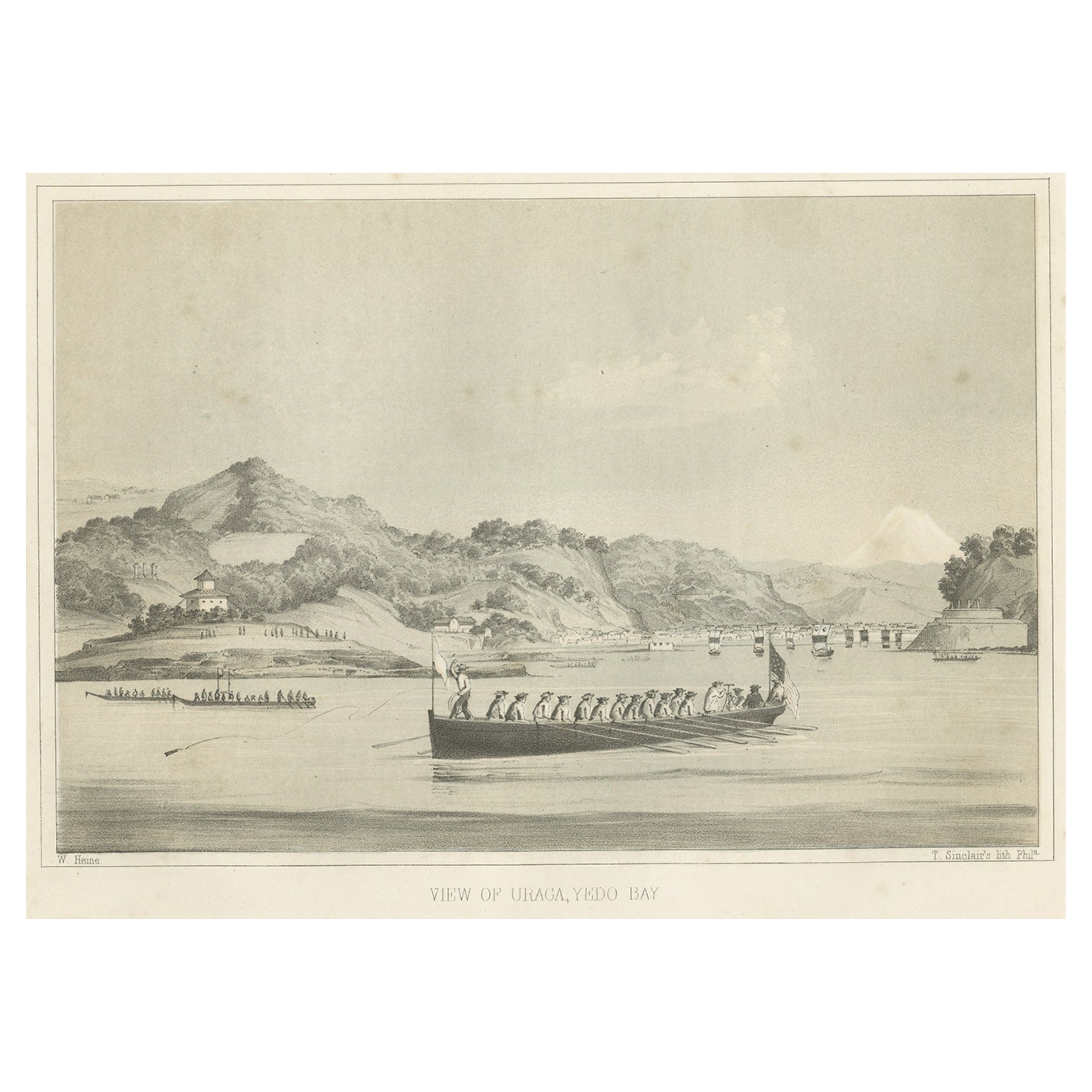Items Similar to A Hizen Katana in koshirae
Want more images or videos?
Request additional images or videos from the seller
1 of 8
A Hizen Katana in koshirae
About the Item
A Hizen Katana in koshirae
Signed 肥前國河内大掾藤原正廣
Hizen kuni kawachi daijō Fujiwara Masahiro
-
Early Edo Period (1615-1867)
-
NBTHK Hozon Tōken
-
Nagasa [length]: 72 cm
Sori [curvature]: 1.4 cm
Motohaba [bottom width]: 2.9 cm
Sakihaba [top width]: 2.1 cm
Motokasane [bottom thickness]: 5.5 mm
-
Sugata [configuration]: Shinogi-zukuri, iori-mune, koshi-zori, chu-kissaki
Kitae [forging pattern]: Ko-itame hada and konuka hada typical of Hizen. Jinie.
Hamon [tempering pattern]: Gunome midare in nie-deki with thick nioiguchi. Ashi, yō, long sunagashi and kinsuji.
Boshi [point]: Round at the end with hakikake kaeri
Nakago [tang]: Ubu, iriyamagata-jiri, ō-sujikai yasurime; two mekugi-ana, mei: “Hizen kuni Kawachi Daijō Fujiwara Masahiro”
-
Origami [paper]: The blade comes with a Hozon Tōken (Sword Worth of Preserving) certificate issued by the Nihon Bijutsu Token Hozon Kyokai.
Koshirae [mounts]: The sword in an antique shirasaya and accompanied by a good antique koshirae with high level fittings and lacquer.
The Hizen school was one of the glorious successes of the Shintō period. It was founded by Tadayoshi, under the sponsorship of the daimyō Nabeshima Naoshige. The Tadayoshi style is based on the work of Yamashiro Rai, and swiftly gained and maintained a reputation for high quality swords, both beautiful and with an excellent cutting ability.
Born in 1607, Hashimoto Sadenji was Tadayoshi’s grandson and student. He is recorded signing his early works with the art name “Masanaga” but there are none existing and, according to the dai-mei tradition, he was probably using more often his master’s name, which in the meantime had changed from Tadayoshi to Tadahiro. In 1624 he made a sword in front of the feudal lord Nabeshima Katsushige, who granted him the smith-name “Masahiro” with a stipend of 20 koku, which could support 20 people, and the possibility to sign his works and to start his own lineage. It is important to note that the daimyō Nabeshima engaged Masahiro directly, due to his superior ability. In 1628 Masahiro is documented to be entitled to use the qualification “Kawachi Daijo” but it seems that for some reasons he chose not to add it to his signature until 1641.
Even if the main style of the Hashimoto family was based on suguha hamon, Masahiro worked mainly in midare, as seen on this blade. The reason might be that the daimyō Nabeshima, who commissioned the work, was very fond of Soshu Gō’s style, who used a midareba with strong nie.
Due to the great success of this style, numerous generations of swordsmiths signed Masahiro throughout the Edo Period.
The sword shows the typical konuka-hada, thought to be the result of Hizen smiths attempting to replicate the nashiji-hada of the great Yamashiro masterpieces. The name comes from the fact that this type of hada resembles rice bran (konuka).
- Dimensions:Height: 72 in (182.88 cm)Width: 2.9 in (7.37 cm)Depth: 0.55 in (1.4 cm)
- Materials and Techniques:
- Place of Origin:
- Period:
- Date of Manufacture:meta XVII secolo
- Condition:
- Seller Location:Milano, IT
- Reference Number:1stDibs: LU4250238387072
About the Seller
5.0
Recognized Seller
These prestigious sellers are industry leaders and represent the highest echelon for item quality and design.
Established in 2005
1stDibs seller since 2018
10 sales on 1stDibs
Typical response time: 1 hour
- ShippingRetrieving quote...Ships From: Milano, Italy
- Return PolicyA return for this item may be initiated within 7 days of delivery.
More From This SellerView All
- Dangae do tosei gusoku A blue-laced samurai armor with cuirass of double styleLocated in Milano, ITDangae do tosei gusoku A blue-laced samurai armor with cuirass of double style Edo Period, 18th century Kabuto [helmet]: Black lacquered eboshi-nari kabuto, in the form of this ...Category
Antique 18th Century Arms, Armor and Weapons
MaterialsIron
- Go-Mai Uchidashi Dō Tosei Gusoku Samurai Armor Decorated with an Embossed RabbitLocated in Milano, ITGo-mai uchidashi do tosei gusoku Samurai armor decorated with an embossed rabbit Edo period, 19th century This samurai armor is complete and original, with consistent elements...Category
Antique 19th Century Japanese Metalwork
MaterialsIron
- Okitenugui Kabuto Samurai Helmet Shaped as a Head Towel Saika, Early Edo PeriodLocated in Milano, ITOkitenugui kabuto Samurai helmet shaped as a head towel Saika, early Edo period, 17th century The Haruta armorers who moved to Kii province in the early 17th century, took the name from the village where they worked, Saika, near Wakayama, possibly on request of the local daimyo, Asano Yukinaga, a great armour amateur. Specialised in the construction of plate helmets, they produced mainly two typologies of kabuto: one with six plates covered with a chrysanthemum-shaped plate on top and one shaped as a “head towel”, called okitenugui. The latter type of kabuto employs very heavy plates crafted in a curved manner and was improved in order to make it resistant to firearms. This okitenugui kabuto features some distinctive decorations of the Haruta school, including the application of cut-out iron elements, including eyebrows, washers and lozenge-shaped decorations on the sides. The ring on the top, however, is a rare feature and could be used to hold a small war flag.Category
Antique 17th Century Metalwork
MaterialsIron
- Hon-kozane ni-mai do tosei gusokuLocated in Milano, ITHon-kozane ni-mai do tosei gusoku Samurai armor in revival style Edo Period, 17th to 18th century Signature on kabuto: Jōshū jū Saotome Ietada Kabuto [helmet]: A russet iron (tetsu sabiji) sixty-two plate kabuto, each mounted with twenty-five small tapered standing rivets (ko-boshi) of decreasing size; the front plate, larger than the others, is fitted with two lines of rivets, while the rear one is left empty, for a total of 1.550 rivets. The typical "Saotome-byo", an extra rivet which is almost an additional signature of the Saotome armorers, is visible inside. Maedate [helmet crest]: Kuwagata (stylized horns) with shakudo kuwagata-dai (support) fitted with three hanabishi (flower-shaped family crest) and a large gilt-wood peony Menpō [mask]: A russet iron (tetsu sabiji) ressei-men (mask with fierce expression) Dō [cuirass]: Ni-mai dō (made in two parts) with hon-kozane (true scale) construction. Stencilled leather plates with engraved shakudo borders, fine pierced kanamono (application) bearing a hanabishi. Sode [shoulder guards]: Large type (ō-sode), with fine kanamono and decorations. Kote [sleeves]: In russet iron, with a hanabishi on the back of the hand (tekko). Haidate [thigh guard]: Of hakama type (full trousers), made of tied rectangular iron plates. Suneate [shin guards]: Finished in black urushi lacquer. Accessories: A saihai (commander’s baton); high-level kara-bitsu (storage box) With its large sode (shoulder guards) and old-fashioned construction, the style of the armor is reminiscent of the medieval suits...Category
Antique Late 17th Century Japanese Arms, Armor and Weapons
MaterialsIron
- Toppai kabuto, Signed Haruta Yoshimasa and dated 1802Located in Milano, ITToppai kabuto, Samurai helmet from the Kajiwara clan. Edo period, dated 1802. Signatures: 筑藩士官 梶原 景泰 命春田 昌芳造之 享和二年壬 秋也 Chikushū (?) Shikan (officer) Kajiwara Kageyasu (?) Mikoto (lo...Category
Antique Early 19th Century Japanese Arms, Armor and Weapons
MaterialsIron
- Samurai Mask with a Fierce Expression Ressei MenpoLocated in Milano, ITSamurai mask with a fierce expression Ressei Menpo DATE Edo period (1615 - 1867), 18th century A red lacquered high-level mask, with fierce (res...Category
Antique 18th Century Japanese Metalwork
MaterialsIron
You May Also Like
- 18th C Rare Samurai Katana Sword Storage Case.Located in Fukuoka, JPFine Samurai Katana Storage Container with Gilded Crest This fine Samurai Katana storage container is a stunning example of Japanese craftsmanship. It ...Category
Antique 18th Century Japanese Edo Arms, Armor and Weapons
MaterialsWood, Giltwood
- Illusion in Design: New Trends in Architecture and InteriorsBy Rizzoli International PublicationsLocated in New York, NYAuthor Paul Gunther and Gay Giordano Cutting-edge examples of the use of optical illusion in design—from trompe l’oeil to anamorphosis—to solve various challenges, be they space or budget related, or that act as aesthetic features in architecture and the fields that rub elbows with it: art, design, and furniture. This magical volume presents the startling world of illusion in design as employed by today’s architects, interior designers, furniture designers, and others at work bending the appearance of reality for purposes of aesthetics or practicality or fun. From a faux bookcase that masks a room or Prohibition-style bar, to the mind-boggling Escher-like effects achieved by Casa Ceramica, whose optical illusion of a floor dips into valleys and rises into mounds (but is in reality flat), the book is a revelation and an inspiration. It offers to us the possibility that nearly anything can be done, if it can be imagined—even in our own homes. The authors look at residences across the globe, as well as spaces beyond the home, that utilize a myriad of surprising techniques. Included are projects by conceptual designers such as Studio Malka and Vector Architects, as well as established practitioners such as Ferguson and Shamamian, G. P. Schafer, Peter Pennoyer...Category
21st Century and Contemporary Books
MaterialsPaper
- Advertising in the USSR in the 1920s, La Pub in URSS French BookLocated in North Hollywood, CALa Pub in URSS dans les annees 20 Anikst, Mikhail Published by Editions du Chene, 1987 This work describes the extraordinary emulation aroused in Russian a...Category
20th Century European Baroque Books
MaterialsPaper
- Living in the ForestBy PhaidonLocated in New York City, NYA spectacular collection of 50 magnificent contemporary houses across the globe, each built to exist harmoniously amid the trees. Take a walk through luscious jungles, get lost among snowy evergreens, and look out from mossy banks across vast Nordic fjords in Living in the Forest...Category
2010s Chinese Books
MaterialsPaper
- Antique Print of the Americans in a Boat in Uraga, Yedo Bay in Japan, 1856Located in Langweer, NLAntique print titled ‘View of Uraga, Yedo Bay'. View of Uraga, Japan. This print originates from 'Narrative of the expedition of an American squadron to the China seas and Japan, per...Category
Antique 19th Century Prints
MaterialsPaper
- In Stock in Los Angeles, Beaumarly Paris by Gilbert Costes, AssoulineBy Assouline PublishingLocated in Beverly Hills, CABeaumarly Paris (Hardcover) In stock in Los Angeles Icons of the Parisian lifestyle, Beaumarly establishments encompass more than twenty ultra-stylish cafés, hotels, nightclubs, and restaurants dotted around the mythical City of Light, from the heart of the Louvre to the rooftop of the Centre Pompidou, from Saint-Germain-des-Prés to the Golden Triangle, from Pigalle to the Bastille. Created by Thierry and Gilbert Costes, who over thirty years have been transforming the way Parisians experience their city, Beaumarly properties include Café Marly, Café Beaubourg, Hôtel Amour, Brasserie Thoumieux, and Club Matignon. Each distinctive Beaumarly venue offers a journey for the senses born of close collaborations with the biggest names in architecture, art, and design, such as Christian de Portzamparc...Category
21st Century and Contemporary American Modern Books
MaterialsPaper
Recently Viewed
View AllMore Ways To Browse
Antique Steel Sword
Armored Gauntlet
Salute Cannon
Framed British Cartridges
Royal Bodyguard Archers
Silver Hare Ornament
Antique Revolver Case
Baroque Gun Rack
Dagger Cane
Dagger Scissors
Estwing Hammer Used
Estwing Hammer Vintage
Estwing Hammers Used
Estwing Vintage
Helmet Dragoon
Knight Handle Dagger
Mameluke Sword
Pewter Powder Flask





